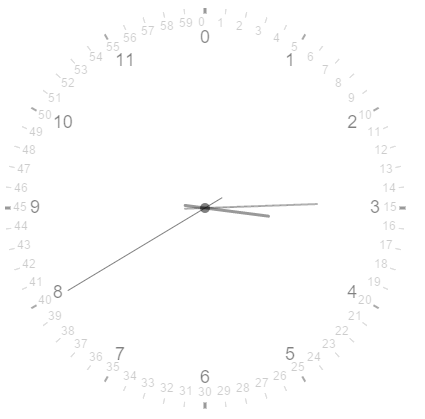
For H5, canvas can be said to be its most distinctive feature. With it, we can freely draw various graphics on the web page, make some small games and so on. There are many tutorials on how to use the canvas tag on the Internet, so I won’t introduce them here. Today we will use canvas to make a small clock. The complete code is herehttps://github.com/wwervin72/HTML5-Clock.
So first of all, I used two canvases on this page, one to draw the static clock dial and scales, and the other to draw the three hands of the clock, and then used positioning to make them overlap. Then there is nothing to say here, the code is attached below.
<canvas id="plate"> 画表盘 </canvas> <canvas id="needles"> 画时针 </canvas>
var plate=document.getElementById('plate');
var needles=document.getElementById('needles');
needles.setAttribute('style','position:absolute;top:8px;left:8px;'); //这里因为chrome里面,body的magin值为8px,所以我这里就没设为0了。
var cntP=plate.getContext('2d');
var cntH=needles.getContext('2d');
plate.width=800;
plate.height=500;
needles.width=800;
needles.height=500;Now that the preparations are done, we are ready to draw the clock. I first defined a constructor that draws the clock face.
function drawclock(cnt,radius,platelen,linewidth,numLen,NUMLEN){
this.cnt=cnt;
this.radius=radius;
this.platelen=platelen;
this.linewidth=linewidth;
this.numLen=numLen;
this.NUMLEN=NUMLEN;
this.getCalibCoor=function(i){
//获得表盘刻度两端的坐标
var X=200+this.radius*Math.sin(6*i*Math.PI/180);
var Y=200-this.radius*Math.cos(6*i*Math.PI/180);
var x=200+(this.radius-this.platelen)*Math.sin(6*i*Math.PI/180);
var y=200-(this.radius-this.platelen)*Math.cos(6*i*Math.PI/180);
// 获得分钟数字的坐标
var numx=200+(this.radius-this.platelen-this.numLen)*Math.sin(6*i*Math.PI/180);
var numy=200-(this.radius-this.platelen-this.numLen)*Math.cos(6*i*Math.PI/180);
//获得小时数字的坐标
var numX=200+(this.radius-this.platelen-this.NUMLEN)*Math.sin(6*i*Math.PI/180);
var numY=200-(this.radius-this.platelen-this.NUMLEN)*Math.cos(6*i*Math.PI/180);
return {X:X,Y:Y,x:x,y:y,numx:numx,numy:numy,numX:numX,numY:numY};
};
this.drawCalibration=function(){ //画刻度
for(var i=0,coorObj;i<60;i++){
coorObj=this.getCalibCoor(i);
this.cnt.beginPath();
this.cnt.moveTo(coorObj.X,coorObj.Y);
this.cnt.lineTo(coorObj.x,coorObj.y);
this.cnt.closePath();
this.cnt.lineWidth=this.linewidth;
this.cnt.strokeStyle='#ddd';
i%5==0&&(this.cnt.strokeStyle='#aaa')
&&(this.cnt.lineWidth=this.linewidth*2);
i%15==0&&(this.cnt.strokeStyle='#999')
&&(this.cnt.lineWidth=this.linewidth*3);
this.cnt.stroke();
this.cnt.font='10px Arial';
this.cnt.fillStyle='rgba(0,0,0,.2)';
this.cnt.fillText(i,coorObj.numx-7,coorObj.numy+3);
i%5==0&&(this.cnt.fillStyle='rgba(0,0,0,.5)')
&&(this.cnt.font='18px Arial')
&&(this.cnt.fillText(i/5,coorObj.numX-5,coorObj.numY+5));
}
};
}
var clock=new drawclock(cntP,200,5,1,10,25); //实例化一个表盘对象
clock.drawCalibration();
The most important part here should be to obtain the coordinates of the scale and digital drawing. I placed the starting point of the scale on the edge of the dial, then subtracted the length of the scale from the radius of the dial to get the location of the end point of the scale, and then used angles and trigonometric functions to get the coordinates of the two points. Finally, you can draw the scale of the dial. The same method is used to draw the numbers on the dial below. The center of the dial here is placed at (200,200). At this point we have drawn a static clock face.
Below I define a constructor for drawing the clock pointer.
function clockNeedle(cnt,R,lineWidth,strokeStyle,lineCap,obj){
this.R=R;
this.cnt=cnt;
this.lineWidth=lineWidth;
this.strokeStyle=strokeStyle;
this.lineCap=lineCap;
this.obj=obj;
this.getNeedleCoor=function(i){
var X=200+this.R*0.8*Math.sin(i); //起点的坐标
var Y=200-this.R*0.8*Math.cos(i);
var x=200-20*Math.sin(i); //终点的坐标
var y=200+20*Math.cos(i);
return {X:X,Y:Y,x:x,y:y};
};
this.drawNeedle=function(){
var d=new Date().getTime();
var angle;
switch(this.obj){
case 0:
angle=(d/3600000%24+8)/12*360*Math.PI/180;
break;
case 1:
angle=d/60000%60/60*360*Math.PI/180;
break;
case 2:
angle=d/1000%60/60*360*Math.PI/180;
break;
}
var coorobj=this.getNeedleCoor(angle);
this.cnt.beginPath();
this.cnt.moveTo(coorobj.x,coorobj.y);
this.cnt.lineTo(coorobj.X,coorobj.Y);
// this.cnt.closePath();
this.cnt.lineWidth=this.lineWidth;
this.cnt.strokeStyle=this.strokeStyle;
this.cnt.lineCap=this.lineCap;
this.cnt.stroke();
}
}
There are two things that need to be said here: 1. When we get the milliseconds of the current time and then convert it to hours, when we take modulo 24 to calculate the hours of the day, we need to add 8 here. 2. If If you want to use the lineCap attribute, don't use closePath() when setting the path above.
At this point we also need a method to draw the pointer and make it look like it can rotate:
function draw(){
cntH.clearRect(0,0,needles.width,needles.height);
var mzneedle=new clockNeedle(cntH,200,1,'rgba(0,0,0,.5)','round',2);
//最后一个参数0代表画时针,1画分针,2画秒针
var fzneedle=new clockNeedle(cntH,80,3,'rgba(0,0,0,.4)','round',0);
var szneedle=new clockNeedle(cntH,140,2,'rgba(0,0,0,.3)','round',1);
mzneedle.drawNeedle();
fzneedle.drawNeedle();
szneedle.drawNeedle();
cntH.arc(200,200,5,0,2*Math.PI);
cntH.fillStyle='rgba(0,0,0,.5)';
cntH.fill();
}
setInterval(draw,1);
A picture of the clock is attached below:

The above is the entire content of this article, I hope it will be helpful to everyone’s study.




